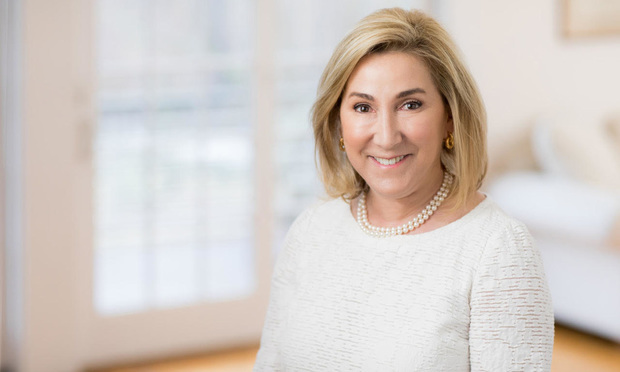LinkedIn Tricks and Tips to Help You in Your Marketing Efforts
Over the years, I have been fortunate to go into law firms and offer an ethics CLE on how to use LinkedIn ethically. Each time I give this CLE, I familiarize myself with any new ethics opinions and—excitingly—new features that can help lawyers market to clients, referral sources and prospective clients.
November 25, 2019 at 12:21 PM
6 minute read
 Stacy West Clark.
Stacy West Clark.
Over the years, I have been fortunate to go into law firms and offer an ethics CLE on how to use LinkedIn ethically. Each time I give this CLE, I familiarize myself with any new ethics opinions and—excitingly—new features that can help lawyers market to clients, referral sources and prospective clients. If you are unaware, LinkedIn has tremendous features that allow you to reach audiences you both know or have always wanted to reach—close and far from your office.
So leaving the applicable ethics rules aside for this discussion today (but hint—check out Rules 1.6 confidentiality, 4.2 communications with person represented by counsel, 7.1 communications regarding lawyer's services ,7.4 communication of fields of practice and specialization)—here are some of my favorite LinkedIn features to help you grow your practice. By the way, I use the basic free service so none of what I am about to share with you will cost you anything.
- Alumni 411—This could be my favorite so let's start with it. Both your college and law schools have a LinkedIn page. On that page, there is a drop-down window called "alumni." When you click on it, you have entered a virtual nirvana of information that allows you to see by year(s), where your classmates work (yes—the company name), what city they are in, what they studied and what they do at their jobs. You want to work for IBM—see which of you classmates is at IBM and reconnect and start a dialogue.
- LinkedIn groups—There are literally millions of groups on LinkedIn and I believe you can join up to 100. There are groups covering industries, niches, laws and so much more. LinkedIn tells you who is the administrator of the group and how many members there are in it and provides ways for you to join. Once you join, you are able to see the chatter among members of the group—such as what is keeping them up at night, questions and challenges they are wrestling with and more. Even though you don't know these people, you can answer questions, start conversations and generally be seen as a thought leader in a community where you might have known no one before. It's like having an eye and entry into a target client audience. You might even use your groups to ask for article ideas (what do they want to see covered to help them in their business) or to ask for folks if they would like to be interviewed in an article you are writing or a presentation you are making. Look at you now starting a relationship with someone you might want to represent!
- Search by title—I work with many lawyers who would love to do work with in-house lawyers. Go to the search box and type in the term under "people" for "general counsel" or "associate general counsel" and you will see who in your network is either a first connection or a second who can introduce you to one of these lawyers who they are directly connected to. Check out their profile and possibly reach out and start a dialogue or offer them something of value that you have prepared (white paper, checklist). Join the groups they are in as well which appear at the bottom of their profiles. You can do the same thing for other titles and companies—check out who in your network is a "president" or "chief compliance officer" or works at Comcast for example.
- Search by Company—You want to get work from Amazon. Search again under people and companies and groups to see who you are connected to and then make a plan to connect—again in a way that offers them something of value—not just, "Let's connect because I want to do your legal work."
- Going to a conference—Let your connections know you are going in a post you share and accomplish two things in doing so: They know you are getting a cutting-edge education in something they might want to know about too. They may want to go and meet up with you one-on-one—a great result.
- Looking for a specialist in something—If you need a potential expert in a case or just looking for someone knowledgeable in some area, post that and watch the recommendations come in quickly.
- Use LinkedIn's message system—Use it as a tool to stay in touch with your connections' work anniversaries and job changes. If your clients or targets are connections, you will receive messages automatically about their work anniversaries or changes of jobs. This is huge intelligence and offers you the opportunity to make a personal touch they will remember. If it is a work anniversary, you can not only congratulate them (don't use the default messages LinkedIn gives you but take a few moments and write something meaningful), but send them a small gift. Personalized heartfelt actions like this solidify relations more than you can imagine. I recently learned that one of the lawyers I had been working with for years had silently switched firms. We connected quickly via the LinkedIn message I received notifying me of her job change and she sent me work immediately. I very much appreciated the heads-up LinkedIn provided me for free.
- Repost things your key clients, referral sources and prospective clients post—On your daily feed, you will see postings from your connections including clients and referral sources and they want as many people as possible to see what they are posting. Repost and share them with your network and of course "like" them. They will appreciate this.
- Add your publications, checklists, helpful tips and more on your feed on a regular basis—I recently read that 80% of posts on social media should be helpful to someone else—with the remaining 20% being self-promotional or newsy about you. Consider your LinkedIn feed as a way to help others succeed with constructive posts designed to help them in their personal or professional lives.
- Make your title on your profile something people would actually search for—So for example, don't have your title be "partner, at the law firm of Dewey Cheatum and Howe." That's a search for Google leading to your website bio. Instead have your title describe your expertise with keywords searchers are using and actively looking for such as "Zoning Lawyer Montgomery County" or "Ladder Defect Lawyer."
Believe me, there are more great marketing activities on LinkedIn. I'd be happy to chat about them and applicable ethics rules (hint—you have a duty to check your endorsements frequently—I can explain why)—at a program on site at your firm. I'm rooting for you!
Stacy West Clark has been helping lawyers and law firms grow revenues for more than 25 years. She is a former attorney with Morgan Lewis & Bockius and was the firm's first marketing director. For more information on her services, go to www.stacyclarkmarketing.com.
This content has been archived. It is available through our partners, LexisNexis® and Bloomberg Law.
To view this content, please continue to their sites.
Not a Lexis Subscriber?
Subscribe Now
Not a Bloomberg Law Subscriber?
Subscribe Now
NOT FOR REPRINT
© 2025 ALM Global, LLC, All Rights Reserved. Request academic re-use from www.copyright.com. All other uses, submit a request to [email protected]. For more information visit Asset & Logo Licensing.
You Might Like
View All

Energy Lawyers Field Client Questions as Trump Issues Executive Orders on Industry Funding, Oversight
6 minute read
Law Firms Mentioned
Trending Stories
- 1E-Discovery Provider Casepoint Merges With Government Software Company OPEXUS
- 2How I Made Partner: 'Focus on Being the Best Advocate for Clients,' Says Lauren Reichardt of Cooley
- 3People in the News—Jan. 27, 2025—Barley Snyder
- 4UK Firm Womble Bond to Roll Out AI Tool Across Whole Firm
- 5Starbucks Hands New CLO Hefty Raise, Says He Fosters 'Environment of Courage and Joy'
Who Got The Work
J. Brugh Lower of Gibbons has entered an appearance for industrial equipment supplier Devco Corporation in a pending trademark infringement lawsuit. The suit, accusing the defendant of selling knock-off Graco products, was filed Dec. 18 in New Jersey District Court by Rivkin Radler on behalf of Graco Inc. and Graco Minnesota. The case, assigned to U.S. District Judge Zahid N. Quraishi, is 3:24-cv-11294, Graco Inc. et al v. Devco Corporation.
Who Got The Work
Rebecca Maller-Stein and Kent A. Yalowitz of Arnold & Porter Kaye Scholer have entered their appearances for Hanaco Venture Capital and its executives, Lior Prosor and David Frankel, in a pending securities lawsuit. The action, filed on Dec. 24 in New York Southern District Court by Zell, Aron & Co. on behalf of Goldeneye Advisors, accuses the defendants of negligently and fraudulently managing the plaintiff's $1 million investment. The case, assigned to U.S. District Judge Vernon S. Broderick, is 1:24-cv-09918, Goldeneye Advisors, LLC v. Hanaco Venture Capital, Ltd. et al.
Who Got The Work
Attorneys from A&O Shearman has stepped in as defense counsel for Toronto-Dominion Bank and other defendants in a pending securities class action. The suit, filed Dec. 11 in New York Southern District Court by Bleichmar Fonti & Auld, accuses the defendants of concealing the bank's 'pervasive' deficiencies in regards to its compliance with the Bank Secrecy Act and the quality of its anti-money laundering controls. The case, assigned to U.S. District Judge Arun Subramanian, is 1:24-cv-09445, Gonzalez v. The Toronto-Dominion Bank et al.
Who Got The Work
Crown Castle International, a Pennsylvania company providing shared communications infrastructure, has turned to Luke D. Wolf of Gordon Rees Scully Mansukhani to fend off a pending breach-of-contract lawsuit. The court action, filed Nov. 25 in Michigan Eastern District Court by Hooper Hathaway PC on behalf of The Town Residences LLC, accuses Crown Castle of failing to transfer approximately $30,000 in utility payments from T-Mobile in breach of a roof-top lease and assignment agreement. The case, assigned to U.S. District Judge Susan K. Declercq, is 2:24-cv-13131, The Town Residences LLC v. T-Mobile US, Inc. et al.
Who Got The Work
Wilfred P. Coronato and Daniel M. Schwartz of McCarter & English have stepped in as defense counsel to Electrolux Home Products Inc. in a pending product liability lawsuit. The court action, filed Nov. 26 in New York Eastern District Court by Poulos Lopiccolo PC and Nagel Rice LLP on behalf of David Stern, alleges that the defendant's refrigerators’ drawers and shelving repeatedly break and fall apart within months after purchase. The case, assigned to U.S. District Judge Joan M. Azrack, is 2:24-cv-08204, Stern v. Electrolux Home Products, Inc.
Featured Firms
Law Offices of Gary Martin Hays & Associates, P.C.
(470) 294-1674
Law Offices of Mark E. Salomone
(857) 444-6468
Smith & Hassler
(713) 739-1250






